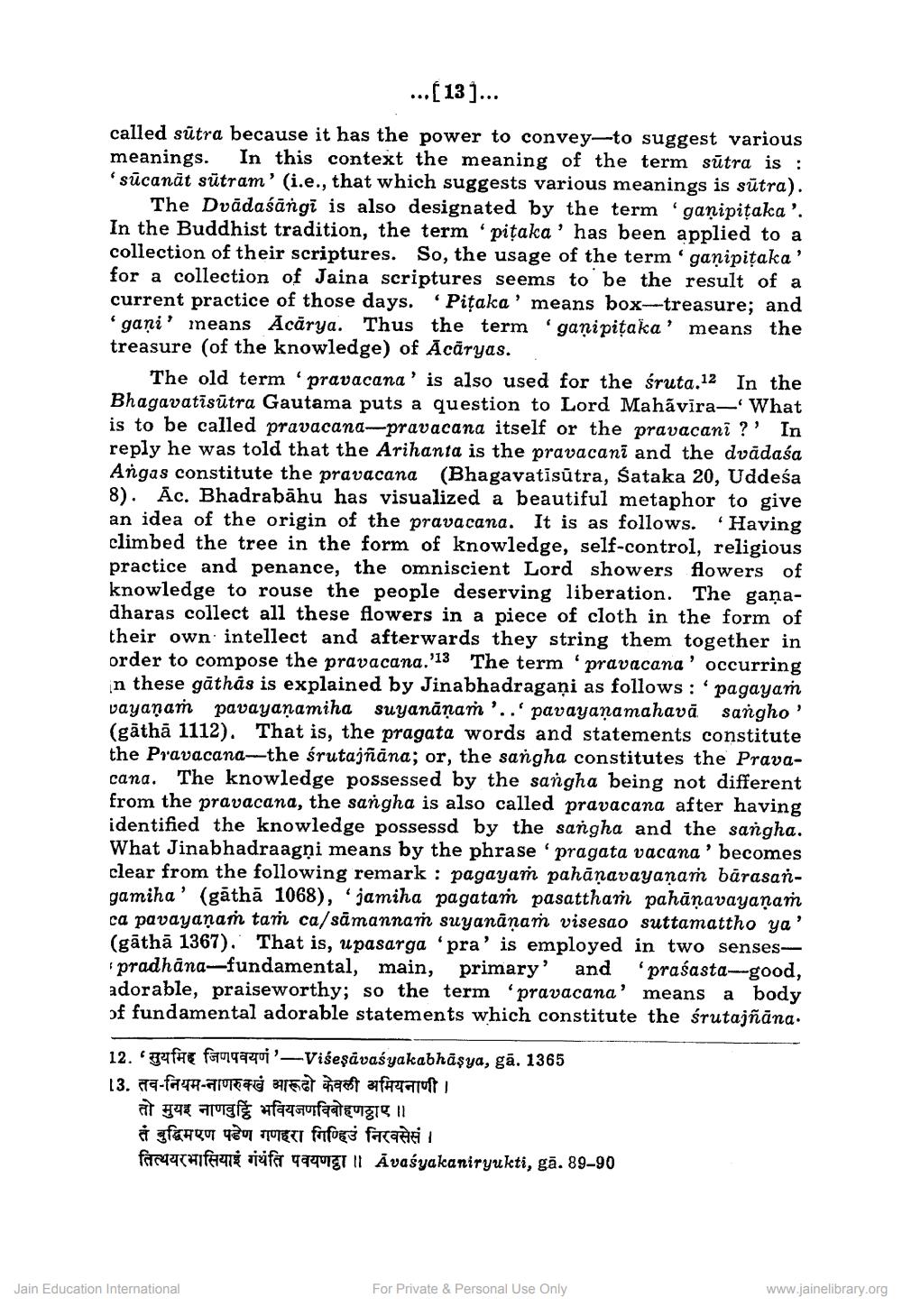________________
... [13)...
called sūtra because it has the power to convey-to suggest various meanings. In this context the meaning of the term sūtra is : sūcanāt sūtram' (i.e., that which suggests various meanings is sūtra).
The Dvādaśāngi is also designated by the term 'ganipițaka'. In the Buddhist tradition, the term 'piţaka' has been applied to a collection of their scriptures. So, the usage of the term 'ganipițaka' for a collection of Jaina scriptures seems to be the result of a current practice of those days. Pitaka' means box-treasure; and 'gami' means Acārya. Thus the term 'ganipițaka' means the treasure (of the knowledge) of Ācāryas.
The old term pravacana' is also used for the śruta.12 In the Bhagavatīsūtra Gautama puts a question to Lord Mahavira—'What is to be called pravacana-pravacana itself or the pravacani ?' In reply he was told that the Arihanta is the pravacani and the dvādaśa Angas constitute the pravacana (Bhagavatisūtra, Sataka 20, Uddeśa 8). Ac. Bhadrabāhu has visualized a beautiful metaphor to give an idea of the origin of the pravacana. It is as follows. Having climbed the tree in the form of knowledge, self-control, religious practice and penance, the omniscient Lord showers flowers of knowledge to rouse the people deserving liberation. The gaņadharas collect all these flowers in a piece of cloth in the form of their own intellect and afterwards they string them together in order to compose the pravacana.'13 The term 'pravacana' occurring in these gāthâs is explained by Jinabhadragani as follows: 'pagayam vayanaṁ pavayanamiha suyanāņaṁ'..' pavayanamahavā sangho' (gāthā 1112). That is, the pragata words and statements constitute the Pravacana-the śrutajñāna; or, the sangha constitutes the Pravacana. The knowledge possessed by the sangha being not different from the pravacana, the sangha is also called pravacana after having identified the knowledge possessd by the sangha and the sangha. What Jinabhadraagņi means by the phrase 'pragata vacana' becomes clear from the following remark : pagayaṁ pahānavayanam bārasangamiha' (gāthā 1068), jamiha pagataṁ pasatthar pahānavayanan ca pavayaņaṁ tam ca/sämannaí suyanāņam visesao suttamattho ya' (gāthā 1367). That is, apasarga 'pra' is employed in two senses
pradhana-fundamental, main, primary' and 'prasasta-good, adorable, praiseworthy; so the term "pravacana' means a body of fundamental adorable statements which constitute the śrutajñāna.
12. gufa faqa oi'--Višeşāvaśyakabhāşya, gā. 1365 13. तव-नियम-नाणरुक्खं आरूढो केवली अमियनाणी।
तो मुयइ नाणवुद्धिं भवियजणविबोहणठाए । तं बुद्धिमएण पडेण गणहरा गिव्हिां निरवसेसं । farraachieni sjöfa 99981 11 Āvaśyakaniryukti, gā. 89-90
Jain Education International
For Private & Personal Use Only
www.jainelibrary.org




